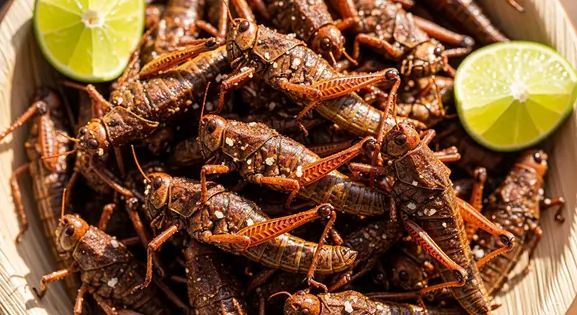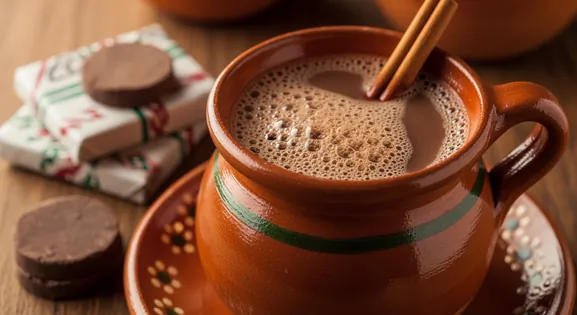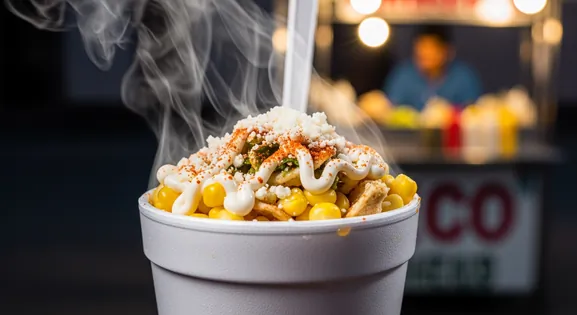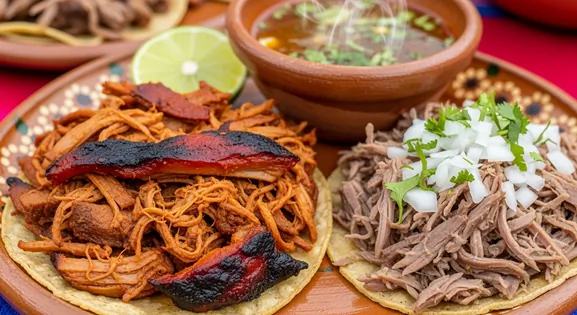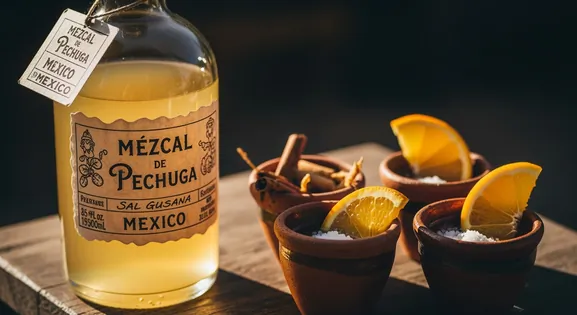Aguachile in Mexico: A Complete Food Lover's Guide
Aguachile

A Culinary Snapshot
Aguachile is a vibrant Mexican seafood dish originating from Sinaloa that features raw shrimp or fish briefly 'cooked' in lime juice, then bathed in a chile-infused liquid that gives the dish its name ('chile water'). Unlike ceviche, aguachile is prepared and served immediately, preserving the seafood's fresh texture and flavor while delivering an invigorating punch of acidity and heat from fresh chiles, complemented by crisp cucumber and red onion.
Tracing the Roots of Aguachile
Aguachile originated in the coastal state of Sinaloa in northwestern Mexico, traditionally prepared by mountain-dwelling ranchers using dried chiltepín chiles crushed with water to create a spicy liquid for preserving and flavoring dried meat. As the dish evolved and reached coastal areas, fresh seafood (primarily shrimp) replaced meat, and fresh lime juice was incorporated to 'cook' the seafood. Now popular throughout Mexico and internationally, the dish represents the perfect marriage of inland chile culture with coastal seafood traditions.
Deconstructing Aguachile: Ingredients and Method
Traditional preparation begins with butterflying fresh shrimp (or slicing fresh fish into thin pieces) and briefly marinating it in fresh lime juice. Meanwhile, a sauce is created by blending fresh green chiles (typically serranos or jalapeños) with cilantro, lime juice, and a touch of salt. The seafood and sauce are combined just before serving, then topped with thinly sliced cucumber and red onion. Critical safety steps include using extremely fresh seafood, maintaining proper refrigeration throughout preparation, and serving immediately.
Key Ingredients of Aguachile
Fresh Shrimp
The star of aguachile, typically butterflied or cut into thin pieces. Its freshness is paramount, as it's consumed raw.
Quality indicator: Look for translucent, firm, and moist shrimp with a clean, oceanic scent, not a strong fishy odor.
Lime Juice
Freshly squeezed lime juice is crucial for "cooking" the seafood through denaturation and providing the dish's signature tangy, acidic base.
Quality indicator: Use only fresh, vibrant green limes for maximum acidity and flavor; avoid bottled lime juice.
Green Chiles (Serrano/Jalapeño)
These provide the dish's characteristic heat and vibrant green color. Serranos are traditional for a sharper spice, while jalapeños offer a milder kick.
Quality indicator: Choose firm, unblemished chiles with a deep green color for optimal flavor and heat.
Local Aguachile Variations in Mexico
Aguachile Verde
The traditional and most common version made with green chiles (typically serranos or jalapeños), lime juice, and cilantro, giving it a bright green color.
Aguachile Negro
A darker variation that incorporates soy sauce or sometimes squid ink, typically made with habanero chiles for extra heat.
Aguachile Rojo
Made with red chiles such as chiltepin or red jalapeños, sometimes incorporating a touch of fruit like mango or passion fruit.
Aguachile de Pescado
Uses thin slices of white fish (typically sea bass or snapper) instead of the traditional shrimp.
Aguachile de Mariscos Mixtos
A mixed seafood version featuring combinations of shrimp, scallops, octopus, and fish.
Enhancing the Flavor: Classic Pairings
Tostadas or Saltine Crackers
Accompaniment
Crispy tostadas or simple saltine crackers are traditionally served alongside aguachile, providing a textural contrast and a vehicle to scoop up the flavorful seafood and sauce.
Michelada or Light Lager
Beverage
A refreshing michelada (beer cocktail with lime, salt, and spices) or a crisp, light Mexican lager perfectly complements the spicy, acidic notes of aguachile, cleansing the palate.
A Traveler's Guide to Authenticity
What to Look For
-
Translucent, plump shrimp or fish
Properly fresh raw seafood should appear somewhat translucent, firm, and moist. Avoid seafood that looks opaque, mushy, or has discolored edges.
-
Refrigerated display case for seafood
Proper refrigeration is essential for raw seafood safety. Look for establishments with visible refrigeration for their seafood.
-
High customer turnover
Busy restaurants cycle through ingredients faster, meaning seafood is less likely to sit around. This is especially important for raw dishes.
-
Clean preparation areas
Visible kitchen cleanliness indicates good food handling practices and reduces cross-contamination risk.
-
Made-to-order preparation
Aguachile should ideally be prepared to order, not sitting pre-made, to ensure optimal freshness and texture.
What to avoid
-
Strong fishy odor
Fresh seafood should smell clean and oceanic, not fishy. A strong fishy smell indicates decomposition has begun.
-
Grey or discolored shrimp
Shrimp should be a translucent greyish-blue when raw (or pinkish if briefly lime-cured). Avoid yellow, black spots, or unnaturally white appearance.
-
Pre-prepared aguachile sitting out
Since aguachile continues to 'cook' in lime juice, pre-made batches can become tough and potentially unsafe if left too long.
-
Cross-contamination signs
Watch for staff handling raw seafood and other foods without changing gloves or washing hands.
-
Warm serving temperature
Aguachile should be served chilled. Room temperature or warm raw seafood dishes present significant safety risks.
Explore Aguachile in Detail: City Guides
Discover where to find the best Aguachile and learn local tips in these cities:
Dietary Information
Dietary Information
Important Note for Travelers: Your safety is our priority. Below are the common allergens associated with the traditional preparation of this dish. However, recipes and ingredients can vary significantly between establishments. Always confirm all ingredients directly with the food vendor before ordering, especially if you have a severe allergy.
Potential Allergens
Dietary Suitability
How to Order Aguachile
Frequently Asked Questions about Aguachile
What is Aguachile?
Aguachile (literally 'chile water') is a traditional Mexican seafood dish from Sinaloa. It features raw shrimp or fish 'cooked' in lime juice and seasoned with a spicy chile sauce, cucumber, and red onion. Unlike ceviche, aguachile is served immediately, offering a fresher, more vibrant taste with pronounced spiciness.
How can I ensure quality when eating Aguachile?
Ensuring quality relies on seafood freshness and handling. Choose establishments with high turnover and a strong reputation for fresh ingredients. While lime juice denatures proteins, it doesn't kill all bacteria, so inherent seafood freshness is paramount. Individuals with compromised immune systems, pregnant women, and young children should opt for fully cooked seafood.
What's the difference between Aguachile and Ceviche?
Both use lime juice to "cook" seafood, but aguachile is prepared and served immediately, emphasizing intense freshness and spiciness from a chile sauce, typically with just shrimp, cucumber, and onion. Ceviche marinates longer, often for hours, and includes a wider variety of ingredients like tomato and avocado, offering a broader flavor profile.
How can I tell if Aguachile is fresh?
Look for translucent, plump, and firm shrimp, not opaque or mushy. The dish should smell clean and oceanic, not fishy. Ingredients should appear vibrant. Choose restaurants with visible refrigeration and high customer turnover, as they receive fresh seafood more frequently.
Is there a vegetarian version of Aguachile?
Yes, vegetarian adaptations are increasingly popular. These versions typically substitute seafood with ingredients like mushrooms (oyster mushrooms), hearts of palm, jicama, or young coconut meat. The lime juice and chile marinade remain similar. When ordering, ask for 'aguachile vegetariano' and confirm no seafood stock is used.
When is the best time to eat Aguachile in Mexico?
Aguachile is best enjoyed during morning to early afternoon hours when seafood is freshest. Seafood establishments often receive deliveries early, making lunch an optimal time. Weekends can also offer fresh supplies due to higher turnover. Many locals consider it ideal for weekend brunches or as a traditional hangover remedy.
Expert How-To Guides about Aguachile
How to Identify Quality Aguachile Vendors
Find the highest quality and most delicious aguachile by evaluating the establishment carefully.
- Look for busy seafood restaurants (marisquerías) with high turnover - empty restaurants may have seafood that's been sitting longer.
- Check if the establishment has proper refrigeration visible for storing seafood.
- Quality vendors will openly display their fresh seafood or have tanks with live product.
- Ask when they receive their seafood deliveries and try to visit on those days.
- Good restaurants will be transparent about the seafood's origin and freshness.
- Notice if locals (especially families) frequent the place - this is often a good sign.
- If seafood smells strongly 'fishy' rather than fresh and oceanic, consider it a warning sign.
How to Eat Aguachile Like a Local
Enhance your aguachile experience by adopting local customs and practices, ensuring you savor every authentic bite.
- Accompany with saltine crackers ('galletas saladas') or tostadas, which are traditionally served alongside.
- Consider ordering a michelada or beer as a traditional pairing.
- Mix all ingredients together before eating to ensure flavors are well distributed.
- Eat relatively quickly after serving - aguachile continues to 'cook' in the lime juice and can become tough if left too long.
- Adjust spice by requesting extra chile sauce ('más chile') or by asking for it mild ('poco picante').
- Don't be shy about asking for lime wedges ('más limón') if you prefer a tangier flavor.
- Some diners enjoy adding a few drops of Maggi or soy sauce for an extra umami kick.
How to Choose the Right Type of Aguachile
Explore the diverse and delicious world of aguachile by understanding its main variations and how to select the perfect style for your palate.
- Traditional Verde: The classic preparation with green chiles (typically serranos or jalapeños) and lime - best for first-timers.
- Aguachile Negro: Made with soy sauce and habanero - more umami flavor and often spicier.
- Aguachile Rojo: Prepared with red chiles for a different heat profile and sometimes includes a touch of fruit.
- Check if they offer different seafood options - while shrimp is traditional, some places offer fish, scallop, or mixed seafood versions.
- For beginners, ask for 'medio picante' (medium spicy) to enjoy the flavor without overwhelming heat.
- In upscale establishments, look for 'aguachile de temporada' (seasonal aguachile) featuring the freshest seasonal ingredients.
- If concerned about raw seafood, some places offer a flash-grilled option ('aguachile sellado').
Our Commitment to Quality
At Tasteplorers, our mission is to provide the most accurate and useful travel information in the world. To achieve this, all content on this site is created through our unique editorial framework. We utilize leading AI research tools, guided by our proprietary prompts, and a multi-stage validation process. This entire system is overseen by our editorial team to ensure everything we publish meets our high standards for accuracy, cultural nuance, and practical value for travelers.
Learn more about our Editorial Process and our Mission.
Explore regions
Europe
Discover Europe's diverse culinary landscape, from Mediterranean flavors to hearty Alpine fare. Learn to navigate markets, decode menus, and eat like a local.
Latin America & Caribbean
Discover the vibrant cuisines of Latin America & the Caribbean. Our expert guide covers everything from Mexican street food to Peruvian ceviche and market tips.
Oceania
Explore Oceania's diverse food scene. Learn about Polynesian earth ovens, Fijian feasts, and the vibrant café culture of Australia and New Zealand.
Southeast Asia
Explore Southeast Asia's diverse food cultures from Thailand to Vietnam. Get expert tips on navigating spice levels, choosing quality vendors, and understanding the rich traditions of the region.
